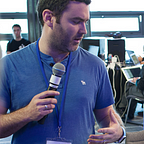Giving a talk in Virtual Reality
A few evenings ago I gave a talk about the basics of Augmented Reality development … from within Virtual Reality! Invited by James Corbett as part of his 3Dcamp meetups, I presented my talk in AltspaceVR, a social VR platform that was acquired by Microsoft last year.
How it works
I used the AltspaceVR app on the Oculus Go, one of Facebook’s VR devices. The Go is one of the first standalone VR devices on the market i.e. it doesn’t need to be connected to a computer or a smartphone to work — all the content is downloaded straight onto the device via WiFi. I’ve tried a lot of VR devices and the Go is impressive; watch out for upcoming User Review and Developer Review posts in this space!
That’s me in my living room in Kildare, Ireland in the middle of my talk! I’ve labelled everything I used:
- MacBook to review my slides beforehand
- Water in case I got thirsty! You can’t see the real world when you’re wearing it so would probably walk into a wall if I tried get a glass of water mid-talk!
- iPhone to text if needed.
- A long power cable so I could stay plugged in but not feel tied down. I was advised to keep plugged in as apparently the Go’s battery doesn’t last too long; and from my limited experience with it, if the battery is too low it may not even start when plugged in until it charges for a while.
All of that isn’t necessary — I just needed the device itself, but in practical terms the other items helped prepare for a hopefully successful presentation.
What went wrong
I was giving the first VR workshop for 3Dcamp so we expected some issues. In the virtual event space you can show slides from Google or Slides.com on a massive cinema-sized screen; but we had major problems getting the slides to advance, they would occasionally get stuck on one slide. James resorted to placing individual slides as images in the room whenever that happened, and eventually Cordula Hansen worked some magic to get them working, but I kept monologuing throughout so it didn’t really slow me down!
What went right
I loved the whole experience — it was fun and a great way to give a talk to people geographically miles apart. Another engineer from Liberty IT, Rory Gallagher attended on an Oculus Rift from Belfast, James was on a Go in Limerick and I don’t actually know where the rest of the audience was actually located! I like going to meetups but don’t go to as many as I’d like, as it can difficult to make time for them — if more were virtual like this, I could attend more.
Work-wise, I spend a large part of my day in Skype meetings — with colleagues in Belfast, Boston and elsewhere. The talk in AltspaceVR was basically the same thing — a meeting, but it was a much more enjoyable experience than my usual meetings! I could “move” around, there’s some interesting options to display content and it’s just a nicer environment that staring at a laptop screen.
I see a future where more enterprise events / meetings are held in VR, provided the platforms and tech improves and overcomes some of the current glitches.
What was a little different
I’ve given a ton of talks over the years and there was a few interesting differences with this one:
- It doesn’t matter what anyone looks like — as everyone is represented by avatars; which may not even be human. So any bias, conscious or otherwise, is less likely which is interesting in inclusivity terms.
- The audience was encouraged to turn off their microphones — so during the talk there isn’t lots of noise from people’s homes. This has the side-effect of making it more difficult to gauge their reaction; usually you’d get a feel from laughter or non-verbal behaviour how a talk is going.
- There are however emojis that participants can select, which float up over their avatar, and actually add positively to the whole experience.
- People can leave by just hitting back in whatever device they’re using — so I it’s much easier for them to leave if you’re not keeping them interested! Leaving a physical meetup in mid-talk may be awkward, here they can just pop out of existence!
- I had thought beforehand that the Q&A piece afterward would be tricky, but it was easy. The avatars have enough movement — head and hand(s) that one can discriminate who’s trying to get your attention to ask a question. There’s also spatially accurate sound — so people’s voices come from where their avatar is. As the presenter however, I was able to turn on megaphone mode which meant my voice sounded the same to all participants, regardless of position. I could do with one of those in work!
- You feel removed from the real world, which is basically one of the main appeals of VR, the concept of “presence” — actually feeling like you are somewhere else. I lifted my headset up slightly at one stage to see my phone to text my wife to see was it her who had rang the doorbell earlier — I had heard it but had no way of seeing who is was, without taking off the headset which I couldn’t do as I was mid-monologue! So while there are benefits to immersion, there are implications aswell of not being “present” in the real world.
Final thoughts
To conclude — I’d recommend the experience to anyone, it was fun and a glimpse of a possible future. I’m looking forward to seeing how the tech progresses in the coming years.
Further info
If you’ve any thoughts or comments, let me know below, and you can get me on Twitter or LinkedIn. Check out Liberty IT here. Thanks, Andy
